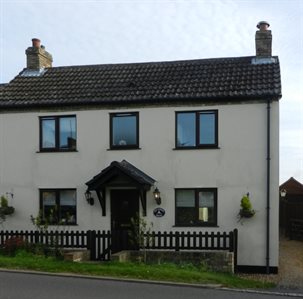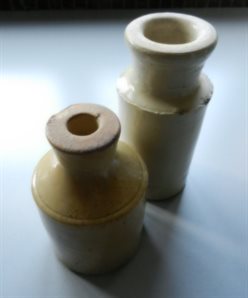Education in Little Staughton Before 1900
This article was written by Jeannette Atkinson and Brenda Foster
A series of Episcopal Visitations in the 1700’s examined the school provision in the county, including Little Staughton. Returns of these visitations (1706, 1709, 1717 and 1720, (summarised by county archivist Patricia Bell, BHRS Volume 81) indicated that there were no schools in Little Staughton at this time.
A summary of Elementary Education in 1818 (BHRS Volume 67) indicates that there was no elementary education in Little Staughton. Subscription for an evening school was available, but the curate H Wade-Gery noted that ‘but from the negligent attendance it [means of education of their children] has never been answered’.
In 1833 it is noted that two Sunday schools exist in Little Staughton; ‘the Established Church has 40 children in their school and the Non-conformists have 100 children’. Both schools were supported by voluntary contributions and the children came from the wider district as well as from Little Staughton.
In 1839 the Whig Government wanted to inspect all schools that received grants but this initiative was resisted by the Established Church until clergymen were appointed as inspectors as well as laymen for the schools run by Dissenters (non-conformists). Little Staughton was noted as having a school in a cottage run by a Dame that had ‘only been open for eight weeks’ and there was ‘hope of building a school room’.
A national questionnaire regarding church schools in 1846/7 revealed that the National School in Little Staughton was well organised. It ran on Sundays (38 boys, 25 girls) and daily (23 boys, 19 girls) plus 12 girls attended a special lace making school that operated on every day of the week (BHRS Volume 67, p120-1). It is noted that ‘the girls read in turns, while the rest of the children are working’ and that ‘the introduction of working lace into this school was occasioned to retain the girls above the ages of mere infancy’.
The Parish Records of Little Staughton [P66/25/3] contain a conveyance of glebe land (land assigned to support the parish priest) in 18 March 1846 from:
- the rector (Rev. Francis Robinson) with the consent of the President and scholars of Corpus Christi College Oxford (patrons of the living) and Thomas, Lord Bishop of Ely
- minister and churchwardens and their sucessors.
This site was endowed for a National School, Playground and Teacher’s House to be held in trust as a school for the education of ‘poor persons’. The land was only leased and Parish Records show that in 1874 the lease for the land was confirmed and extended for 21 years at an annual nominal rent of 5 shillings [P66/25/4].

The old school house 2017 (Copyright Brenda Foster)
The first Education Act, the Elementary Education Act was passed in 1870. This Act was a milestone as it demonstrated government support for all children across the country and it sought to secularise education by allowing the creation of School Boards. Such Boards were formed of local ratepayers who had powers to raise funds, build and run schools, pay fees of the poorest children, make attendance compulsory between the ages of 5 and 13 years and turn church schools into board-run schools. Fortunately, the Act required an audit of schools and Little Staughton was recorded as having ‘no efficient school’ with a ‘requirement for a school for 106 children’. It was noted that Little Staughton National School needed desks, books, a certificated teacher and a classroom for not less than 33 children (BHRS Volume 67, p215). The School Board was formally recognised in Little Staughton on 25th February 1873 but was dismissed by the Education Department in 1886 ‘for its failure to deal adequately with the problem of school attendance’. It was replaced by a Board imposed by the Education Department (BHRS Volume 67, p222).
Religious teaching in the Little Staughton school was contentious. The Established Church and the Non-conformists held differing views and the local Non-conformist chapel had a large congregation. It was resolved that in Little Staughton ‘Ministers of Religion shall enter schoolrooms, and there instruct their classes in Holy Scriptures from 9.00 am to 9.45 am, due regard being paid to the requirements respecting religious teaching set forth in the Elementary Education Act of 1870’ (BHRS Vol 67, p224).
Victorian school head teachers had a hard time and they were readily dismissed. An example of this is George Futcher who was appointed Head Master at Little Staughton on the 27th September 1878 on a salary of £60 per annum [CRT 180/202]. He was an experienced teacher of over 25 years and he started work on 11th October 1878 but was given three months notice on 23rd July 1879. The school log book for 1879 details the frustrations and personal tragedies for this experienced teacher:
- 7th February – many more would be at school if their parents would send them;
- 28th February – some gravel is wanted for the front of the schoolroom, the approach to the school room being almost impassable with mud;
- 28th March – still not enough slates – not one for each pupil;
- 23rd May – a weeks’ vacation owing to the death of the teacher’s wife (Martha aged 54 years).
The national census of 1881 indicates that George Futcher did not work as a School Master again, but he is found remarried and settled as a domestic servant in Kent.
For many years the schoolroom buildings were uncomfortable. In the Little Staughton school log book (BHRS, Volumr 67, page 169) of 21st February 1879 it was noted that there had been no fires for two days in the Little Staughton school room as no coal had been provided, which prevented attendance of some of the scholars and made Mrs Hockliffe (the assistant mistress) sick and unable to attend school. On the 8th February 1895 ‘no writing was attempted in the morning on account of the ink being frozen’!

Doulton inkwells found in the grounds of the old school house in the 1970s (Copyright Brenda Foster)
New items were often added to the school syllabus: in the 1890s drawing was added (Little Staughton School Board fought this addition but eventually gave way, BHRS Volume 67, page 195) and on 18 October 1895 ‘Hand and Eye’ training was commenced. It was noted that ‘the kindergarten geometry finds favour among the children’ (BHRS, Volume 67, page 198).